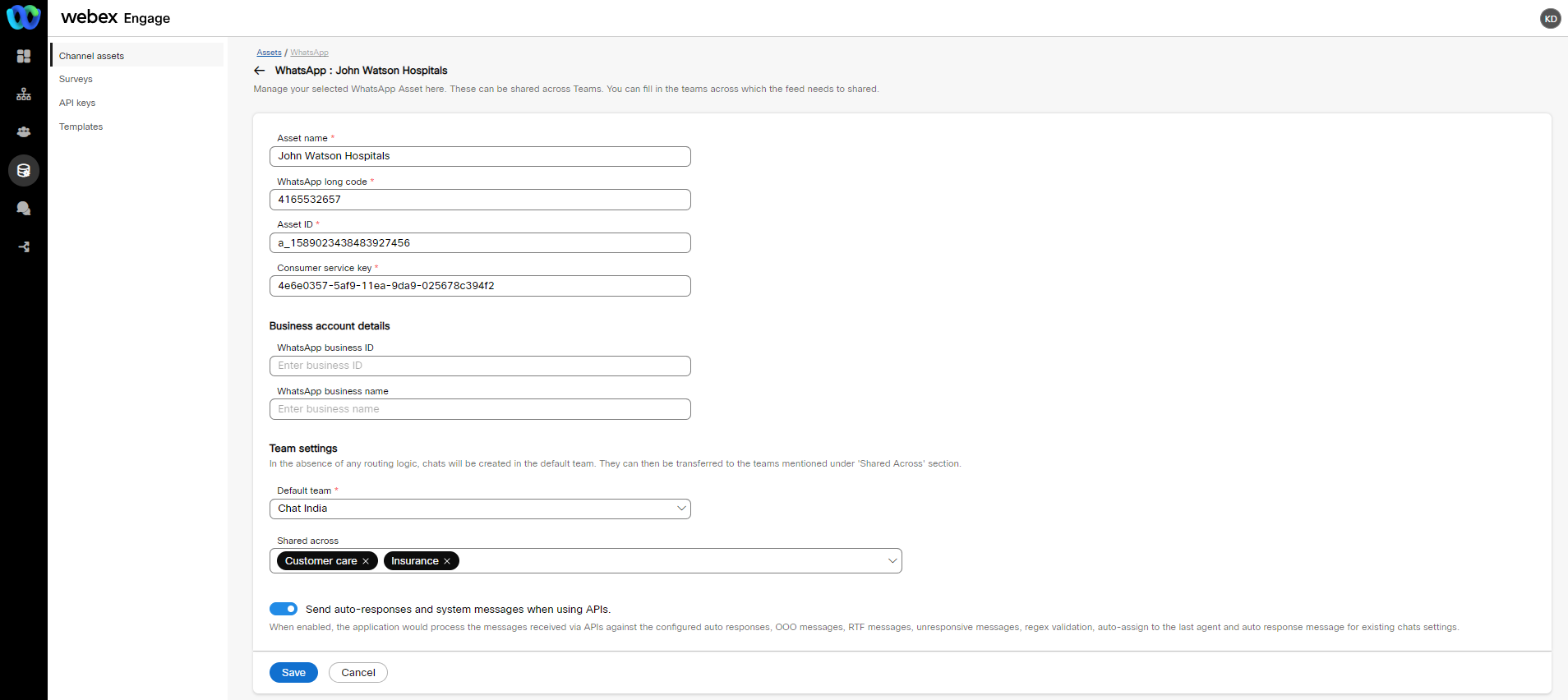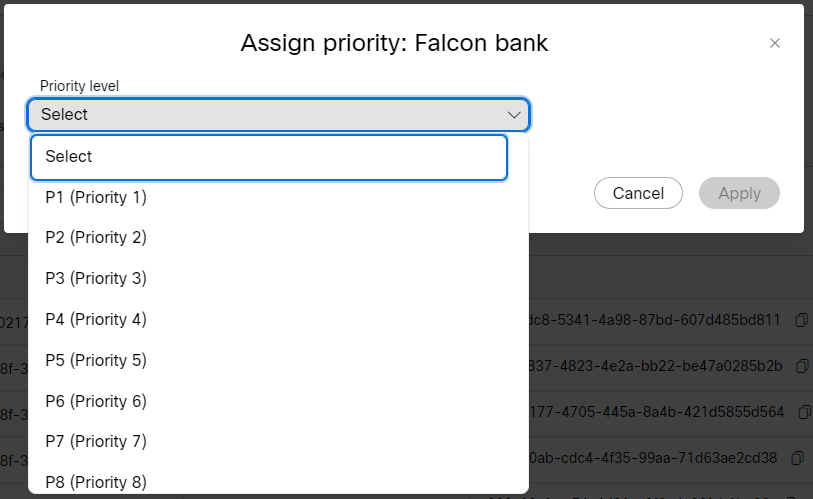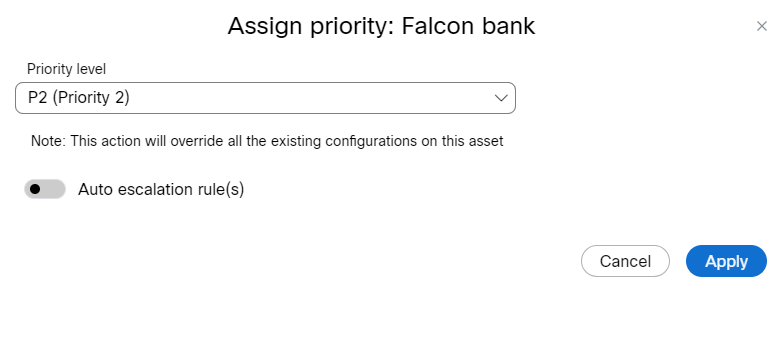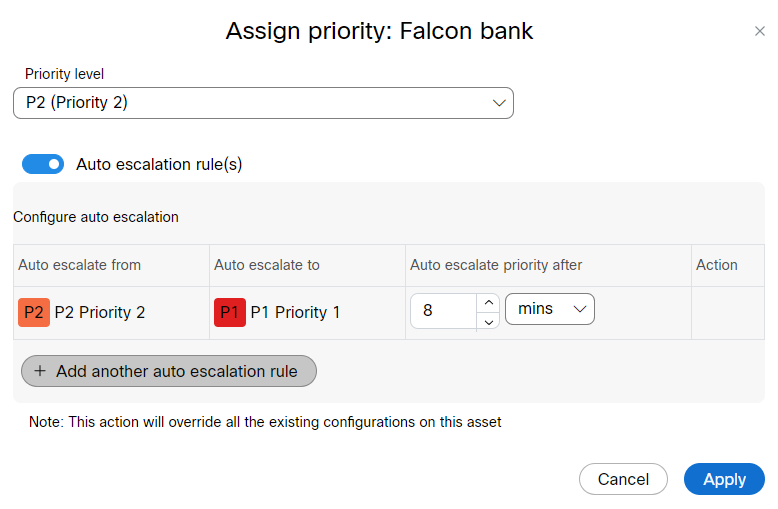WhatsApp Channel
As an administrative user, you can only create a WhatsApp asset from the UI on the Webex Engage React application. You can share the WhatsApp channel asset across different teams. You can transfer conversations within or across teams and assign them to team queues, individual assignees, or skills, just like the behavior of the channels on the Webex Engage application.

Add WhatsApp asset
To add a WhatsApp asset, follow these steps:
-
Login to Webex Engage.
-
Click the Try new version button on the top-right corner of the application.
The Webex Engage React application will launch.
- Navigate to Assets> Channel assets.
- Click the WhatsApp channel tab.

- Click the + WhatsApp asset on the top-right corner of the Channel assets screen.
The following screen appears.

- Enter the Asset name, WhatsApp long code, Asset ID, and Customer service key in the respective fields.
- Enter Business account details, WhatsApp business ID, and WhatsApp business name in the respective fields. The additional information under the business account details section helps to link WhatsApp Business (WAB) registered templates to the assets.
- Select a team from the Default team drop-down list.
- Select the teams from the Shared across drop-down list.
- Turn On the Send auto-responses and system messages when using APIs toggle to process the messages received via APIs against the configured auto-responses, Out-of-Office (OOO) messages, Right to be Forgotten (RTF) messages, unresponsive messages, regex validation, auto-assign to the last agent, and auto-response message for existing chats settings.
- Click Save to create a WhatsApp asset.
Edit WhatsApp asset
To edit a WhatsApp asset, follow these steps:
-
Login to Webex Engage.
-
Click the Try new version button on the top-right corner of the application.
The Webex Engage React application will launch. -
Navigate to Assets> Channel assets.
-
Click the WhatsApp channel tab.

- Click the Edit icon in the Actions column of a specific asset.
Note
Please refrain from editing the Business Account Details of an asset.
The following screen appears on the screen.

- Edit the required fields and click Save changes.
A success message appears on the screen.
Update priority
To update a WhatsApp asset's priority, follow these steps:
- Login to Webex Engage.
- Click the Try new version button on the top-right corner of the application.
The Webex Engage React application will launch. - Navigate to Assets> Channel assets.
- Click the WhatsApp channel tab.

- Click the Update priority icon in the Actions column of a specific asset.
The following pop-up window will appear on the screen.

- Select a Priority from the Priority level drop-down and click Apply.
- If you select a priority other than P1, then the Auto escalation rule(s) toggle appears.

- If you turn ON the Auto escalation rules(s) toggle, the auto escalation configuration options will appear.

- You can select the escalation time from the Auto escalate priority after drop-down in minutes and click Apply.
Note
- As per the chosen priority, you can add number of escalation rules.
Example: If you select priority as P2 then you can add one escalation rule. If you select priority as P3 then you can add two escalation rules, etc.- If you select priority as P1 then the Auto escalation toggle will be greyed, and you cannot select it.
Search WhatsApp asset
To search for a WhatsApp asset, follow these steps
- Login to Webex Engage.
- Click the Try new version button on the top-right corner of the application.
The Webex Engage React application will launch. - Navigate to Assets> Channel assets.
- Click the WhatsApp channel tab.

- Enter the search criterion in the Search input field above the table results.

The respective results will appear on the screen.
Customise display of table
The Customise Display helps you select a specific list of columns you want to preview in the table results.
To view customise table results, follow these steps:
- Click the Customise display drop-down on the top-right corner of the results table.

- Choose the required columns from the list by selecting the checkboxes adjacent to each column name.
You can instantly view the results on the screen by checking and unchecking the checkboxes.
Note
By default, Asset name and Actions columns are preselected and cannot be disabled.
Updated almost 2 years ago
